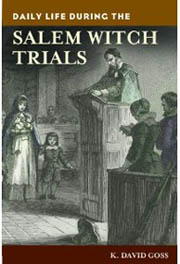Bridget Bishop

Who Was Bridget Bishop?
– Bridget Playfair was born in England in 1640
– Her first husband was named George Wasselbe. They were married in about 1660.
– Bridget emigrated to Salem in the 1660’s. As far as we know, there are no records that mention George coming to New England with Bridget.
– Her second husband was Thomas Oliver. They married July 26, 1666 (Perley, page 443)
– Thomas was a “calendar” by trade.
– Thomas and Bridget had a girl named Christian or Christina, born May 8, 1667. Christina married Elias (?) Mason before 1693. Thomas and Bridget also had a daughter Mary who married Job Hilliard.
– Thomas had had three children by his former wife—two sons, Thomas and John, both born in England before 1637, and a daughter, Ellinor, who married and lived in Nevis in 1693.
– In about 1670, Bridget was tried for fighting with Thomas Oliver. She was convicted a second time a few years later for calling him an “old rogue” and “old devil” on the Sabbath. For punishment they were ordered to stand back to back in the marketplace for an hour, gagged, with notices describing their offenses tied to their foreheads.
– It is rumored that Bridget appeared once in public with a “bloody face; another time, covered with bruises, and her husband said she had also hit him.”
– Thomas died in 1678, leaving Bridget destitute. While Oliver’s will left her with the house and land, any money that was provided for Bridget was taken by his creditors. Part of the land that she owned was sold to her neighbors, the Gedneys. Bridget was forced to petition the town for relief.
– On February 25, 1680, Bridget was brought up on charges for bewitching her 2nd husband to death. She was tried in Boston, but was acquitted chiefly by the Rev. John Hale’s defense. She was tried by the Court of Assistants—a Supreme Court of Appeals that had exclusive jurisdiction in all criminal cases extending to “life, limb, or banishment”.
– Bridget was also tried at one time for stealing brass from William Stacey.
– In 1683, Bridget married Edward Bishop Sr., a sawyer and a well-respected man who had served on various town and county committees and boards while living in Salem.
– Bridget was known to wear a red paragon bodice. Paragon is a type of fabric blended of wool and silk and sometimes camel hair. There is also something called “water paragon”, which may look like water taffeta.
– By a previous marriage, Edward had a son, also named Edward, who was grown and living with his wife Sarah Wilds Bishop, on Ipswich Road, (now Conant Street) in Beverly. Edward Jr. and Sarah were accused of witchcraft later in the summer of 1692. They escaped from jail in Boston in September.
*Note: early scholarship, including Boyer and Nissenbaum’s work, confused Bridget Bishop and Sarah Bishop. Most careful work written after 1993 corrects the mistake.
– At the time of her 1692 trial, Bridget lived where the present day Lyceum Restaurant in Salem is located (on the corner of Church and Washington Streets). She was 52.
– In 1692, she was kept in the Boston prison from about May 12 until May 31, when she was returned to Salem to await trial.
– One testimony from Bridget’s trial says that as Bridget made her way to the meetinghouse for the trial, part of it was pulled down by a demon. A board that had been fastened with nails was found on the floor upon entry.
– From her examination, Bridget was sent to trial on June 2nd, where she was convicted and sentenced to hang. Her hanging took place on June 10, 1692.
Sources:
-Daly, Don. The Tryal of Bridget Bishop,
-Dow, George Francis. Everyday Life in the Massachusetts Bay Colony. Dover Publications, Inc. 1988. ISBN: 0-486-25565-4-
-Norton, Mary Beth, In the Devil’s Snare: The Salem Witchcraft Trials of 1692. Vintage Books, 2002. ISBN: 0-375-70690-9 –
-Perley, Sidney. The History of Salem, Massachusetts, Volume 1,1626-1637. Salem, Mass. Sidney Perley, 1924.





Comments on this entry are closed.